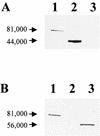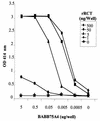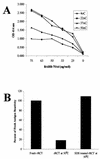Competitive enzyme-linked immunosorbent assay based on a rhoptry-associated protein 1 epitope specifically identifies Babesia bovis-infected cattle
- PMID: 12522037
- PMCID: PMC145267
- DOI: 10.1128/cdli.10.1.38-43.2003
Competitive enzyme-linked immunosorbent assay based on a rhoptry-associated protein 1 epitope specifically identifies Babesia bovis-infected cattle
Abstract
The competitive enzyme-linked immunosorbent assay (cELISA) format has proven to be an accurate, reliable, easily standardized, and high-throughput method for detecting hemoparasite infections. In the present study, a species-specific, broadly conserved, and tandemly repeated B-cell epitope within the C terminus of the rhoptry-associated protein 1 of the hemoparasite Babesia bovis was cloned and expressed as a histidine-tagged thioredoxin fusion peptide and used as antigen in a cELISA. The assay was optimized with defined negative and positive bovine sera, where positive sera inhibited the binding of the epitope-specific monoclonal antibody BABB75A4. The cELISA accurately differentiated animals with B. bovis-specific antibodies from uninfected animals and from animals with antibodies against other tick-borne hemoparasites (98.7% specificity). In addition, B. bovis-specific sera from Australia, Argentina, Bolivia, Puerto Rico, and Morocco inhibited the binding of BABB75A4, confirming conservation of the epitope. The assay first detected experimentally infected animals between 13 and 17 days postinfection, and with sera from naturally infected carrier cattle, was comparable to indirect immunofluorescence (98.3% concordance). The assay appears to have the characteristics necessary for an epidemiologic and disease surveillance tool.
Figures





References
-
- Araujo, F. R., C. R. Madruga, C. R. Leal, M. A. Schenk, R. H. Kessler, A. P. Marques, and D. C. Lemaire. 1998. Comparison between enzyme-linked immunosorbent assay, indirect fluorescent antibody and rapid conglutination test in detecting antibodies against Babesia bovis. Vet. Parasitol. 74:101-108. - PubMed
-
- Barry, D. N., B. J. Rodwell, P. Timms, and W. McGregor. 1982. A microplate enzyme immunoassay for detecting and measuring antibodies to Babesia bovis in cattle serum. Aust. Vet. J. 59:136-140. - PubMed
-
- Figueroa, J. V., L. P. Chieves, G. S. Johnson, W. L. Goff, and G. M. Buening. 1994. Polymerase chain reaction-based diagnostic assay to detect cattle chronically infected with Babesia bovis. Rev. Lat. Am. Microbiol. 36:47-55. - PubMed
-
- Goff, W. L., G. G. Wagner, T. M. Craig, and R. F. Long. 1982. The bovine immune response to tick-derived Babesia bovis infection: serological studies of isolated immunoglobulins. Vet. Parasitol. 11:109-120. - PubMed
Publication types
MeSH terms
Substances
Grants and funding
LinkOut - more resources
Full Text Sources
Research Materials

